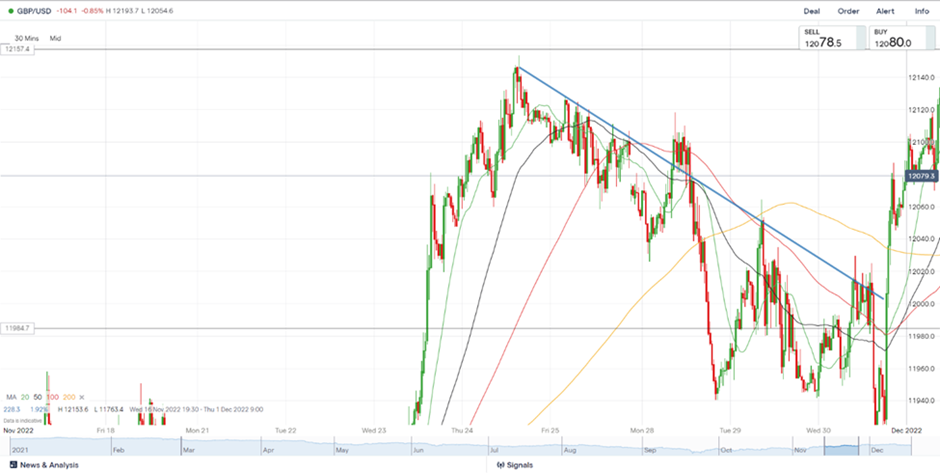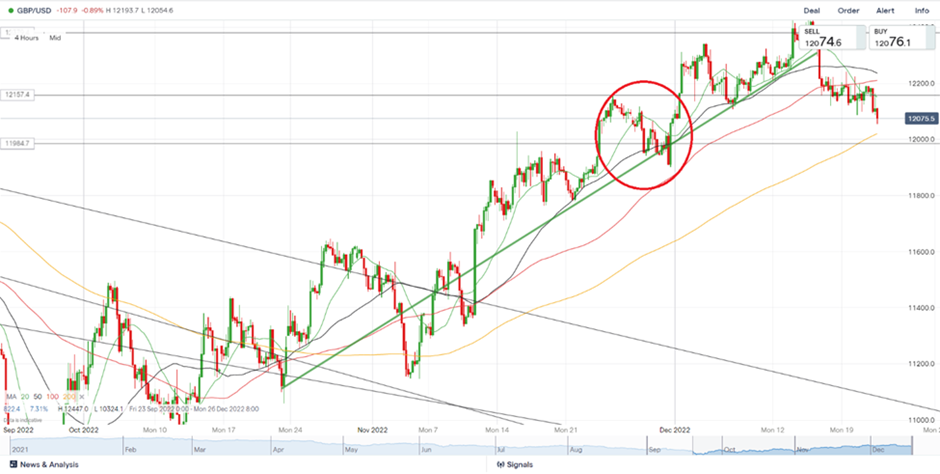How to trade trendlines in Forex
Among the numerous strategies of trading in financial and commodity markets, the main one is still trend trading, namely trendline trading. For most traders, this is the simplest and clearest strategy. It was popular many years ago, still is, and will be popular in the foreseeable future, because by opening positions with the trend, you can get the highest profit at minimal risk. This post explains how to draw and trade trendlines.
Do you want to start trading Forex? Open an account on Roboforex!What is a trendline?
The answer to this question is very simple and complicated at the same time. After identifying the trend direction, you need to draw a line through the lows if it’s an uptrend, or through the highs if it’s a downtrend. In other words, a line drawn along support levels is a trendline in an uptrend, and a line drawn along resistance levels is a trendline in a downtrend. Apparently, it’s all simple.
The difficulty is that a novice trader isn’t always able to correctly identify a trend and draw a line, which naturally entails a wrong decision and a loss from an unsuccessful trade.
Support line

Image: Support line
On this EUR/USD chart, you see a strongly pronounced uptrend. The blue line drawn along the support levels clearly shows the trend direction and is an ascending support line.
There is a rule that a trendline is valid if it’s drawn through at least three lower or higher points, i.e., support or resistance levels.
Therefore, the above example demonstrates a valid trendline confirmed by several touches of the price.
Resistance line

Image: Resistance line
This example displays a downtrend of USD/CHF. Here, the trendline connects the highs, or resistance levels, and clearly shows the trend direction. After the price touches the highs three times during pullbacks, the trendline can be safely deemed confirmed, and a trader can prepare to sell the asset.
It’s worth noting – and professional traders know it perfectly well – that during pullbacks, the price doesn’t always clearly touch support or resistance lines. As the trend develops, bears or bulls are constantly trying to take control of the situation, and their efforts can be more active or less active. That is why the price may either not reach the trendline or cross it, making a false breakout.
Therefore, novices should not wait for obvious touches of a trendline, otherwise, instead of becoming traders, they may become “waiters”, which will hardly bring them any income. On the other hand, waiting skills may be good for some other activity or job, but this article does not include any tips on that.
How to draw trendlines correctly
As has been said, for a trendline to be valid, the price must touch it at least three times. Also, not to make a mistake identifying a trend, you should consider the price action on both large and small scales.
When the scale is large, a trader risks mistaking a pullback or correction for trend development, which entails wrong decisions and losses on open positions. To avoid it, you should scale the chart down and look at a longer time frame, i.e., see the situation globally, not locally.
Here is an example of a “local” look at a situation:

Image: Trendlines
The chart shows a strongly pronounced downtrend of GBP/USD. Validity of the trendline drawn through the highs on the pullbacks is confirmed by several touches.
But if you look at it “globally” in a 4-hour time frame, you will see the following picture:

Image: Downtrend of GBP/USD
In the previous example with a larger scale (30-minute time frame), the circled section of the price chart looked like a strong downtrend, whereas in this example, it’s just a short pullback within a long uptrend. Therefore, wrong identification of a trend may result in a mistaken decision and a loss.
In this case, by viewing the chart in a 4-hour time frame, a trader can identify the long-term uptrend and use the pullback to the ascending support line (trendline) to buy GBP/USD and earn quite a good profit.
Advice to beginners
While two or three touches may be enough for an experienced trader to confirm a trend, a beginner had better wait for at least three touches and combine a trendline with such indicators as, for example,moving averages (MAs). If a supposed trendline coincides with a long-term МА, this may be a confirmation of the trendline. Otherwise, a beginner should wait for one or two more touches.
Bollinger Bands can be used similarly to MAs. If an MA coincides with a trendline, it can serve as interim support or resistance that lets you open a position. Widening of the bands indicates that the trend is strong.
Using МАs and/or Bollinger Bands is also effective for placing protective stop loss orders.
To better evaluate a situation, aside from technical indicators, you should also pay attention to technical analysis figures that are either trend continuation or reversal figures. Formation of the latter after a trendline breakout considerably increases the odds that this breakout is true.
Besides the touches, a trader should look at the trendline angle, which has to be approximately 45 degrees. If less, the trend is either fading and can become flat, or it is simply weak. If more, the price may move rapidly in the same direction, making it hard or even impossible to catch a pullback to a price suitable for opening a trade.

Image: Price breaks resistance
On the USD/JPY chart above, the price breaks resistance and leaves the long-term range. The angle is much more than 45 degrees. The movement is so fast that there are only two real touches of the trendline, the price mostly moves above it, and therefore catching a good entry price is practically impossible.
And again, you should not disregard longer time frames or more “global” assessment of situations. The more touches of the trendline within a long-term trend, the steadier the trend.
Which time frame to choose
There is no all-inclusive tip as to choosing time frames, because it primarily depends on a trader’s strategy. It is best to make short-term trades in 15-minute, 30-minute, and 45-minute time frames, medium-term trades in 1- to 4-hour time frames, and long-term trades in 4-hour or longer time frames. Medium and long-term price movement is considered the most reliable and steadiest.
Trendline trading strategies
The most common and reliable trendline trading strategy is, of course, opening trades with the trend. In the case with an uptrend, after you identify it and draw an ascending support line (trendline), buy positions are opened on pullbacks to this line. They can be closed when the price approaches an ascending resistance line, or based on your own calculations or predictions.

Image: Opening trades with the trend
In this example, you see USD/CHF in a 2-hour time frame that displays a steady uptrend. Its validity is confirmed after three touches of the support line, which can be a signal to buy near the trendline. In this case, each pullback to this line can be used to open a long position. A stop loss should be placed a little lower than the line, taking into account that the price can cross it. The resistance levels that the price has bounced off earlier (horizontal lines) can become profit targets. Clearly, a trader can get a very good risk/reward ratio.
Here is an example of selling with a downtrend:

Image: Steady uptrend USD/CHF
In this US CRUDE chart, you see an obvious downtrend. After its identification and drawing a descending trendline (resistance line), the optimal strategy is to sell on pullbacks to this line and place a stop loss order above it, taking into account the false breakout of the line. The risk/reward ratio is also good here.
Bolder or more experienced participants can trade against the trend, i.e., sell on the highs in an uptrend, anticipating a pullback and testing of support, or buy on the lows, anticipating a pullback to resistance. This strategy is not recommended for beginners, as the risk of losing money is too high. The price of an instrument can rise or fall rapidly and without pullbacks like in the above example of USD/JPY.
Another strategy is to sell or buy an asset after a trendline (support or resistance line) is broken on a pullback to it. Its breakout may signal a trend reversal, but when the movement is strong, breakouts may be false.
Which strategy beginners should use
It is quite clear that the best strategy for beginners is to trade with the trend during pullbacks to the trendline. All other strategies are too risky and, therefore, more suitable for professional traders.
Best Forex brokers


Summary
The main advantages of trendline trading are its simplicity and rather high reliability. Experienced and successful traders can easily draw a trendline when the trend is just forming or resuming. After that, it’s enough to catch pullbacks to the trendline and trade with the trend, getting along without additional indicators, patterns, etc. Trendline trading is not effective enough for short-term traders (intraday, scalpers) because short-term price movement is volatile and can hardly be called a trend.
FAQs
What is a trendline?
It’s a line drawn through the highs in a downtrend or the lows in an uptrend.
What confirms the validity of a trendline?
A trendline is valid if the price touches it at least three times. When the price is rising, it touches an ascending support line. When the price is falling, it touches a descending resistance line.
What is the most popular and reliable trendline trading strategy?
Opening positions with the trend on pullbacks to the trendline.
What is the riskiest trendline trading strategy?
It is to sell when the price is rising or to buy when the price is falling, counting on a pullback.
Glossary for novice traders
-
1
Broker
A broker is a legal entity or individual that performs as an intermediary when making trades in the financial markets. Private investors cannot trade without a broker, since only brokers can execute trades on the exchanges.
-
2
Trading
Trading involves the act of buying and selling financial assets like stocks, currencies, or commodities with the intention of profiting from market price fluctuations. Traders employ various strategies, analysis techniques, and risk management practices to make informed decisions and optimize their chances of success in the financial markets.
-
3
Bollinger Bands
Bollinger Bands (BBands) are a technical analysis tool that consists of three lines: a middle moving average and two outer bands that are typically set at a standard deviation away from the moving average. These bands help traders visualize potential price volatility and identify overbought or oversold conditions in the market.
-
4
CFD
CFD is a contract between an investor/trader and seller that demonstrates that the trader will need to pay the price difference between the current value of the asset and its value at the time of contract to the seller.
-
5
Index
Index in trading is the measure of the performance of a group of stocks, which can include the assets and securities in it.
Team that worked on the article
Andrey Mastykin is an experienced author, editor, and content strategist who has been with Traders Union since 2020. As an editor, he is meticulous about fact-checking and ensuring the accuracy of all information published on the Traders Union platform. Andrey focuses on educating readers about the potential rewards and risks involved in trading financial markets.
He firmly believes that passive investing is a more suitable strategy for most individuals. Andrey's conservative approach and focus on risk management resonate with many readers, making him a trusted source of financial information.
Olga Shendetskaya has been a part of the Traders Union team as an author, editor and proofreader since 2017. Since 2020, Shendetskaya has been the assistant chief editor of the website of Traders Union, an international association of traders. She has over 10 years of experience of working with economic and financial texts. In the period of 2017-2020, Olga has worked as a journalist and editor of laftNews news agency, economic and financial news sections. At the moment, Olga is a part of the team of top industry experts involved in creation of educational articles in finance and investment, overseeing their writing and publication on the Traders Union website.
Mirjan Hipolito is a journalist and news editor at Traders Union. She is an expert crypto writer with five years of experience in the financial markets. Her specialties are daily market news, price predictions, and Initial Coin Offerings (ICO).





